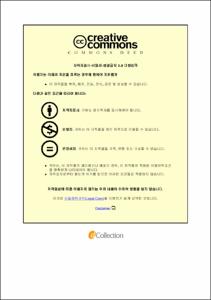Hydrogenation of Non-edible Vegetable Oil by Ni-based Bimetallic Catalysts
- Alternative Title
- 니켈계 이원금속촉매에 의한 비식용 식물유의 수소화 반응
- Abstract
- 비식용 식물유는 현재 사용량의 제한성을 지니고 있는 화석 연료를 대체할 수 있는 유망한 에너지원으로 고려되고 있다. 하지만 비식용 식물유의 연료 품질은 화석 연료에 비해 낮고, 높은 산성과 높은 불포화성 때문에 원료 저장 중, 원치않는 산폐와 중합반응을 일으키는 단점이 존재한다. 이를 방지하기 위해 촉매를 이용한 수소화 반응은 식물유를 업그레이드하는 유망한 방법으로 현재 NiZn/Al2O3 및 NiFe/Al2O3과 같은 Ni 기반의 이원금속촉매가 많은 연구자에 의해 관심의 대상이 되고 있다.
본 연구에서는, 식물유의 수소화 반응을 위해 NiM/γ-Al2O3 이원금속촉매를 테스트하였으며 이원금속 종류, 함량과 반응조건에 대한 효과를 알아보았다. 수소화 반응을 거친 업그레이드된 식물유는 요오드가 (IV) 와 전산가 (TAN) 분석을 통해 반응효율을 평가하였다. γ-Al2O3를 지지체로 한 NiM/γ-Al2O3 (M1=Zn, Fe, Cu 및 Co, 15 wt% Ni, Ni/M1 molar ratio=2/1; M2=Pd 및 Pt, 15 wt% Ni, Ni/M2 molar ratio=20/1) 이원금속촉매는 공침법으로 합성하였으며 BET, XRF, XRD 그리고 XPS 등으로 촉매 특성을 분석하였다. 이들 촉매에 대한 테스트는 충전층반응기에서 350 oC, 30 bar및 LHSV=1 h-1조건에서 수행되었다. 스크리닝 테스트 결과, 가장 유망한 활성을 보인 NiCu/γ-Al2O3 촉매에 대한 반응조건 영향을 알아보기 위해 온도 (250-400 oC), 압력 (5-80 bar) 및 LHSV(1-10 h-1) 를 변화시켜 측정하였다. 또한, NiCu 함량 (0-23wt%)에 따라 산가 및 요오드가 저감 효율을 확인하였으며, 최적의 활성을 갖는 이원금속촉매의 안정성평가도 수행하였다. 반응원료로는 1/1 (v/v%) 의 cashew nut shell liquid (CNSL) 와 palm acid oil (PAO) 혼합물을 사용하였다 (IV:186.30, TAN42.90).
반응활성 결과, 구리와 니켈 성분의 조합에 의한 시너지효과에 의해, NiCu/γ-Al2O3촉매의 활성이 크게 향상됨을 확인하였다. 반응촉매 중, Ni(18.1)Cu(4.9)/γ-Al2O3 (Ni/Cu molar ratio=4/1)이 350 oC, 30 bar, LHSV=1 h-1의 조건에서 IV및 TAN제거율이 81.5%및 100.0%로 가장 높게 나타났다. 전반적으로, 비식용 식물유에 포함된 불포화 이중결합과 카르복실산이 NiCu/γ-Al2O3 이원금속촉매로부터 수소화 반응에 의해 현저하게 저감 되었다.
Non-edible vegetable oil can be considered as a promising alternative energy source to replace the limited amounts of fossil fuels for power generation. However, the fuel quality of non-edible vegetable oil is inferior to that of fossil fuels, and its high acidity and high degree of unsaturation give rise to corrosiveness and undesirable polymerization reactions during storage. The catalytic hydrogenation process is a promising path by which to upgrade vegetable oil. At present, Ni-based bimetallic catalysts containing NiZn/Al2O3 and NiFe/Al2O3 have attracted a great deal of attention due to their excellent catalytic activity and stability levels.
In this study, non-edible vegetable oil hydrogenation over NiM/γ-Al2O3 bimetallic catalysts was investigated to assess the effects of the bimetal type, bimetal contents and reaction conditions. To evaluate the extent of upgraded oil, the iodine value (IV) and the total acid number (TAN) were analyzed. γ-Al2O3 supported NiM/γ-Al2O3 (M1=Zn, Fe, Cu and Co, 15 wt% Ni, Ni/M1 molar ratio=2/1; M2=Pd and Pt, 15 wt% Ni, Ni/M2 molar ratio=20/1) bimetallic catalysts were prepared by a co-impregnation method and characterized by BET, XRF, XRD and XPS. Screening tests of the bimetal catalysts were conducted under the condition of 350 oC, 30 bar and LHSV=1 h-1 in a packed-bed reactor. The NiCu/γ-Al2O3 catalyst was selected as a promising catalyst, and the activity test was performed under a range of temperatures (250-400 oC), pressures (5-80 bar) and LHSVs (1-10 h-1). In addition, the influence of NiCu bimetal content (0-23 wt% in the catalyst) was assessed, and a longevity test was also conducted. A 1/1 (v/v %) mixture of cashew nut shell liquid (CNSL) and palm acid oil (PAO) was selected as the feed (IV:186.30, TAN:42.90).
In the activity test, NiCu/γ-Al2O3 was found to enhance the catalytic performance considerably with the synergistic effect between nickel and copper. The best catalyst, Ni(18.1)Cu(4.9)/γ-Al2O3 (Ni/Cu molar ratio=4/1), showed that the IV and TAN removal efficiency rates could reach 81.5% and 100.0%, respectively, at 350 oC, 30 bar, and LHSV=1 h-1. Overall, the unsaturated double bonds and the carboxylic acid from non-edible vegetable oil showed significant decreases by the hydrogenation process over the NiCu/γ-Al2O3 bimetallic catalyst.
- Issued Date
- 2018
- Awarded Date
- 2018. 8
- Type
- Dissertation
- Keyword
- Biofuel Hydrogenation Bimetallic Catalyst
- Publisher
- 부경대학교
- Affiliation
- 부경대학교 대학원
- Department
- 대학원 화학융합공학부
- Advisor
- 우희철
- Table Of Contents
- CONTENTS i
ABSTRACT iv
LIST OF TABLES vi
LIST OF FIGURES vii
1. INTRODUCTION 1
1.1. Research background 1
1.2. Literature review 6
1.2.1. Feedstocks: CNSL and PAO 6
1.2.2. Hydrogenation 11
1.2.3. Catalysts 12
1.3. Objectives 13
2. MATERIALS AND EXPERIMENTAL 14
2.1. Materials 14
2.2. Catalyst preparation 14
2.3. Catalyst characterization 18
2.3.1. Brunauer-Emmett-Teller (BET) 18
2.3.2. X-ray fluorescence (XRF) 18
2.3.3. X-ray diffraction (XRD) 19
2.3.4. X-ray photoelectron spectroscopy (XPS) 19
2.4. Catalytic upgrading 20
2.5. Analysis of upgraded oil 23
3. RESULTS AND DISCUSSIONS 25
3.1. Catalyst characterization 25
3.1.1. Brunauer-Emmett-Teller (BET) 25
3.1.2. X-ray fluorescence (XRF) 27
3.1.3. X-ray diffraction (XRD) 29
3.1.4. X-ray photoelectron spectroscopy (XPS) 37
3.2. Catalytic activity test 41
3.2.1. Screening test for bimetal effect 41
3.2.2. NiCu/γ-Al2O3: reaction condition effect 43
3.2.2.1. NiCu/γ-Al2O3: temperature effect 43
3.2.2.2. NiCu/γ-Al2O3: pressure effect 45
3.2.2.3. NiCu/γ-Al2O3: LHSV effect 47
3.2.2.4. NiCu/γ-Al2O3: Cu contents effect 49
3.2.3. Longevity test 51
3.3. Study of catalyst deactivation 53
4. CONCLUSIONS 55
ABSTRACT IN KOREAN 56
REFERENCES 58
ACKNOWLEDGEMENT 66
- Degree
- Master
- Files in This Item:
-
-
Download
 Hydrogenation of Non-edible Vegetable Oil by Ni-based Bimetallic Catalysts.pdf
기타 데이터 / 2.26 MB / Adobe PDF
Hydrogenation of Non-edible Vegetable Oil by Ni-based Bimetallic Catalysts.pdf
기타 데이터 / 2.26 MB / Adobe PDF
-
Items in Repository are protected by copyright, with all rights reserved, unless otherwise indicated.